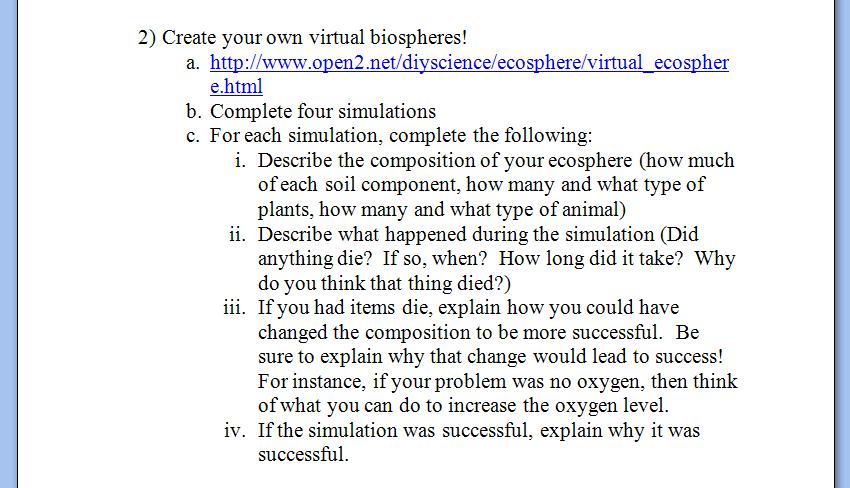This is an image of the portion of the lesson that describes the process. It uses no technology, at all. The students don't even use computers to conduct research.
Artifact #1: Biosphere project (Environmental Science class)
This is an image of part of an assignment that I gave to my Environmental science class at the beginning of a unit on the biosphere and biomes. In it, they were required to go to the indicated website, which has a program that conducts biosphere simulations, based on criteria that the students input.

This assignment allowed students to get a hands-on experience with the effect of changes in a biosphere, without having to wait the months and months covered by the computer simulation. It took a fairly abstract idea (the interconnectedness of all living things within a biosphere) and made it visual, with animations and graphs of data (carbon dioxide levels, oxygen levels, etc.). Furthermore, since the students are required to make choices as to what goes into the biosphere, it helped them connect to what was happening, and forced them to think about how their choices, in general, might damage/improve their biosphere. While doing this with a terrarium is fun, it lacks the immediate teachable moment created by being able to see the progress of many months time ticking through in a few minutes. In this case, technology greatly improves the lesson and learning experience.
Before this program, I had primarily used technology in the classroom in a very limited capacity. I was much more likely to do something like my baseline evidence shows, which involves student research, but is devoid of technology. Even though I have always been very comfortable with computers, I limited student use to internet research and document publishing. After Dr. Roberts's website analysis assignment in Organic Chemistry, in which we were asked to develop a page that evaluated different science-related websites, a whole world of computer possibilities opened up. This was further enhanced by the work I did in various groups throughout other classes (the National Geographic website was invaluable in Environmental Chemistry!), and a professional development led by some cohort-mates on using applets in the classroom. Now, I am actually using computers as a teaching tool, rather than just a publishing tool.
Artifact #2: MCEP Thesis Lesson Plan (whole plan in PDF, available here)
This is an image of a portion of the lesson plan. In this portion of the plan, students watch a brief introductory video, and then use a website with a gas laws simulator to try and establish what gas laws were most at play in the introductory video. For the procedure followed during the gas properties simulator inquiry, click the link above for a PDF of the entire lesson plan. The procedure is included in the worksheet following the lesson plans.
I like using videos with lessons, but this is the first lesson I have developed that combines a video with a computer-based inquiry project. Like the simulator in the biosphere project, this simulator allows the students to change many perimeters, and still get instantaneous results. Going through the same process, with actual lab equipment, would be limited by time and materials, so the students would not be able to go through nearly as many iterations, as they can with this simulator. Again, I was introduced to these types of websites, first through the Website Analysis Project, and then through later projects and through the assistance of cohort-mates.